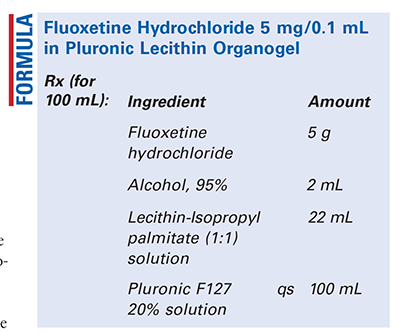US Pharm. 2020;45(5):48-CV3.
Method of Preparation: Lecithin-isopropyl palmitate 1:1 solution—Prepare by mixing 0.2 g sorbic acid, 50 g of soy lecithin, and 50 g of isopropyl palmitate.
Pluronic F127 20% solution—Prepare by mixing 0.2 g sorbic acid, 20 g of Pluronic F127, and sufficient purified water to make 100 mL.
Fluoxetine HCl 5 mg/0.1 mL in Pluronic Lecithin Organogel—Calculate the quantity of each ingredient for the amount to be prepared. Accurately weigh or measure each ingredient. Pulverize the fluoxetine to a very fine powder. Add the alcohol and mix to form a smooth paste. Incorporate the lecithin:isopropyl palmitate solution to the paste and mix well. Geometrically, incorporate the Pluronic F127 20% gel to final volume and mix, using a mechanical shearing method, without incorporating air into the mixture. Package and label.
Use: Fluoxetine is indicated for acute and maintenance treatment of major depressive disorder; acute and maintenance treatment of obsessions and compulsions in patients with obsessive-compulsive disorder; acute and maintenance treatment of binge-eating and vomiting behaviors in patients with moderate-to-severe bulimia nervosa; and acute treatment of panic disorder with or without agoraphobia.1
Packaging: Package in tight, light-resistant containers.
Labeling: Keep out of reach of children. Discard after ____ [time period]. Apply exact dose as directed. For external use.
Stability: A beyond-use date of up to 6 months may be used for this preparation.2
Quality Control: Quality-control assessment can include theoretical weight compared with actual weight, specific gravity, active drug assay, color, texture–surface, texture–spatula spread, appearance, feel, rheologic properties, and physical observations.3
Discussion: Fluoxetine hydrochloride (Prozac, Sarafem, C17H18F3NO.HCl, MW 345.79) occurs as a white to off-white crystalline powder that is freely soluble in alcohol and sparingly soluble in water (14 mg/mL). Each Prozac Pulvule contains fluoxetine hydrochloride equivalent to 10 mg, 20 mg, or 40 mg of fluoxetine as well as the following inactive ingredients: starch, gelatin, silicone, titanium dioxide, iron oxide, and other inactive ingredients. The 10-mg and 20-mg Pulvules also contain FD&C Blue No. 1, and the 40-mg Pulvule contains FD&C Blue No. 1 and FD&C Yellow No. 6.1,4
Alcohol (ethyl alcohol, ethanol, grain alcohol, C2H5OH, MW 46.07) is a clear, colorless, mobile, and volatile liquid with a slight characteristic odor and a burning taste. It is miscible with chloroform, glycerin, and water.5
The term lecithin (egg lecithin, soybean lecithin, vegetable lecithin) describes a complex mixture of acetone-insoluble phosphatides in combination with triglycerides, fatty acids, and carbohydrates. Lecithin derived from vegetable sources has a bland or nutlike taste and varies in color from brown to light yellow. Lecithin is practically insoluble in water, polar solvents, and cold vegetable and animal oils; when mixed with water, however, it hydrates to form emulsions.6
Isopropyl palmitate (C19H38O2, MW 298.51) is a colorless, mobile liquid with a very slight odor. Isopropyl palmitate is used as an emollient, oleaginous vehicle, and solvent, and it has good spreading characteristics. Isopropyl palmitate is soluble in acetone, castor oil, cottonseed oil, alcohol, and mineral oil. It is insoluble in water, glycerin, and propylene glycol.7
Pluronic F127 is a block copolymer of ethylene oxide and propylene oxide that is used as an emulsifying agent, solubilizing agent, and wetting agent. It is generally available in powdered form. Pluronic F127 either is odorless or has a very mild odor. Pluronic F127 melts at about 56°C and is freely soluble in water, alcohol, and isopropyl alcohol.8
REFERENCES
1. RxList. Prozac. www.rxlist.com/prozac-drug.htm. Accessed April 6, 2020.
2. Peacock GF, Sauvageot J. Evaluation of the stability of fluoxetine in Pluronic lecithin organogel and the determination of an appropriate beyond-use date. IJPC. 2014;18(3):253-255.
3. Allen LV Jr. Summary of quality-control testing for sterile and nonsterile compounded preparations, part 1: physical and chemical testing. IJPC. 2019;23(3):211-216.
4. U.S. Pharmacopeia/National Formulary [current revision]. Rockville, MD: U.S. Pharmacopeial Convention, Inc.; April 2020.
5. Fenton ME. Ethanol. In: Sheskey PJ, Cook WG, Cable CG, eds. Handbook of Pharmaceutical Excipients. 8th ed. London, England: Pharmaceutical Press; 2017:356-359.
6. Shah HC, Singh KK. Lecithin. In: Sheskey PJ, Cook WG, Cable CG, eds. Handbook of Pharmaceutical Excipients. 8th ed. London, England: Pharmaceutical Press; 2017:538-541.
7. Quinn ME. Isopropyl palmitate. In: Sheskey PJ, Cook WG, Cable CG, eds. Handbook of Pharmaceutical Excipients. 8th ed. London, England: Pharmaceutical Press; 2017:497-498.
8. Pirjanian A, Alvarez-Nunez F. Poloxamer. In: Sheskey PJ, Cook WG, Cable CG, eds. Handbook of Pharmaceutical Excipients. 8th ed. London, England: Pharmaceutical Press; 2017:688-693.
The content contained in this article is for informational purposes only. The content is not intended to be a substitute for professional advice. Reliance on any information provided in this article is solely at your own risk.
To comment on this article, contact rdavidson@uspharmacist,.com.





